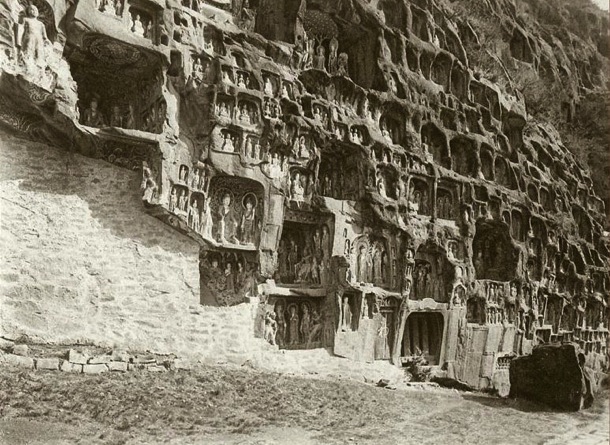FEATURES
Southern Heaven Gate 南天門, Gubeikou | China Heritage Quarterly
Thousand Buddha Cliffs, Sichuan
四川千佛岩石窟
Sang Ye with Geremie R. Barmé



At the time of Boerschmann's photographic expedition over 17,000 Buddha statues ranging from the time of the Northern and Southern dynasties right up to the Ming could be found at the Thousand Buddha Cliffs on the eastern bank of the Jialing River north of Guangyuan, Sichuan province 四川省廣元市嘉陵江東岸.[Fig.1]
When the Sichuan-Shaanxi highway was built under the aegis of the National government in 1935 nearly ten thousand of these statues were destroyed. Thereafter, further depredations were commonplace and, today, only some 7,000 figures remain, mostly in a damaged or much-reduced state.[Fig.2]
In 1991, the local government built a viewing corridor for tourists. In the process they added bars and grills to many of the niches and grottoes to prevent further destruction and theft. This was tantamount to being another round of despoliation.[Fig.3]
A former head of the Thousand Buddha Cliffs Culture Relics Station observes:
Although the Cliffs are a protected state relics, administration of this heritage site has always been inadequate. Even now the Cliffs are right next to a highway and are constantly subject to exhaust fumes as well as the impact of heavy vehicles. We are on a main artery into Sichuan province and not even the Minister of Transportation has the power to change the routing of the road. That'd probably take an order from the Premier himself. But on the positive side, this road has its benefits—we are the only sculpture cliffs located on a major road, so it's very convenient. So, it should have a direct tourist pay-off. But there's the irony: we're right next to the road so most people just have a look as they drive by. They don't stop to buy an entry ticket to come and look up close. Anyway, we can't exactly build a wall around the cliffs to prevent people from looking. We couldn't afford to do even if we wanted to: how many tickets would we have to sell to be able to pay for such a huge wall?
Many of the remaining Buddhas have no heads that's because when the road was first built [in the 1930s] no one was put in charge of protecting the caves. Anyone could steal a head if they wanted to. After all ten thousand Buddhas had been blown up to build the road, what did a few more heads matter?
After Liberation [in 1949], after Premier Zhou Enlai signed the document to list this as a protected site [in 1961], two people were hired to look after the Cliffs. Not long after the Red Guards rebelled and brought their hoes to chop off Buddha heads. They got every head within reach. They couldn't smash the biggest heads so they had to be satisfied with chopping off their noses.
Not that many were left following the destructive frenzy. And by then people knew that cultural relics were worthy something, so from the late 1980s people started stealing them. So some of the better-preserved heads were pilfered and smuggled out of China. We had no choice to construct metal grills over the caves. Everyone knows they reduce visibility and that to install them you have to drill holes into the cliffs, which naturally affects the relics. But we had to do it: a small act of vandalism to prevent a greater vandalism.
Everyone in China knows that foreigners stole some Buddhas and wall paintings from the Mogao Caves at Dunhuang before Liberation. To be totally honest, only a few Buddhas and a limited number of wall paintings were taken. But because the state uses every possible occasion to cast recriminations over it, everyone knows about that vandalism.
What about here? There have been a number of waves of destruction from the 1930s. Countless Buddhas have been pulverized. As for the wall paintings, well, most of them have been obliterated. Although some visitors know a little of this history, most people don't have a clue.
People don't know about this destruction because the state doesn't talk about it. 'There's a difference between foreigners and Chinese' [nei wai you bie 内外有别]. Since you can't blame anyone for the destruction wrought by your own hand, you're too embarrassed to make anything of it.
|


